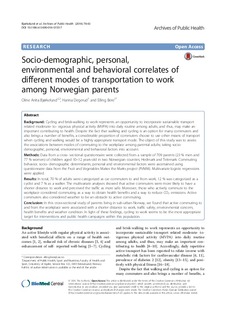| dc.contributor.author | Bjørkelund, Oline Anita | |
| dc.contributor.author | Degerud, Hanna | |
| dc.contributor.author | Bere, Elling | |
| dc.date.accessioned | 2018-01-11T12:39:42Z | |
| dc.date.available | 2018-01-11T12:39:42Z | |
| dc.date.issued | 2016 | |
| dc.identifier.citation | Archives of Public Health (2016) 74:43 | nb_NO |
| dc.identifier.issn | 2049-3258 | |
| dc.identifier.uri | http://hdl.handle.net/11250/2477011 | |
| dc.description.abstract | Background: Cycling and brisk-walking to work represents an opportunity to incorporate sustainable transport related moderate- to- vigorous physical activity (MVPA) into daily routine among adults, and thus, may make an important contributing to health. Despite the fact that walking and cycling is an option for many commuters and also brings a number of benefits, a considerable proportion of commuters choose to use other means of transport when cycling and walking would be a highly appropriate transport mode. The object of this study was to assess the associations between modes of commuting to the workplace among parental adults; taking socio- demographic, personal, environmental and behavioral factors into account.
Methods: Data from a cross- sectional questionnaire were collected from a sample of 709 parents (23 % men and 77 % women) of children aged 10–12 years-old in two Norwegian counties, Hedmark and Telemark. Commuting behavior, socio- demographic determinants, personal and environmental factors were ascertained using questionnaire data from the Fruit and Vegetables Makes the Marks project (FVMM). Multivariate logistic regressions were applied.
Results: In total, 70 % of adults were categorized as car commuters to and from work, 12 % was categorized as a cyclist and 7 % as a walker. The multivariate analyses showed that active commuters were more likely to have a shorter distance to work and perceived the traffic as more safe. Moreover, those who actively commute to the workplace considered commuting as a way to obtain health benefits and a way to reduce CO2 emissions. Active commuters also considered weather to be an obstacle to active commuting.
Conclusion: In this cross-sectional study of parents living in sub-urban Norway, we found that active commuting to and from the workplace were associated with a shorter distance to work, traffic safety, environmental concern, health benefits and weather condition. In light of these findings, cycling to work seems to be the most appropriate target for interventions and public health campaigns within this population. | nb_NO |
| dc.language.iso | eng | nb_NO |
| dc.publisher | Biomed Central | nb_NO |
| dc.rights | Navngivelse 4.0 Internasjonal | * |
| dc.rights.uri | http://creativecommons.org/licenses/by/4.0/deed.no | * |
| dc.title | Socio-demographic, personal, environmental and behavioral correlates of different modes of transportation to work among Norwegian parents | nb_NO |
| dc.type | Journal article | nb_NO |
| dc.type | Peer reviewed | nb_NO |
| dc.description.version | publishedVersion | nb_NO |
| dc.subject.nsi | VDP::Medisinske Fag: 700::Helsefag: 800::Samfunnsmedisin, sosialmedisin: 801 | nb_NO |
| dc.source.pagenumber | 1-9 | nb_NO |
| dc.source.volume | 74 | nb_NO |
| dc.source.journal | Archives of Public Health | nb_NO |
| dc.source.issue | 43 | nb_NO |
| dc.identifier.doi | 10.1186/s13690-016-0155-7 | |

